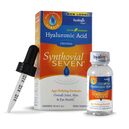Your body’s need for Hyaluronic Acid (HA)
 Hyaluronic Acid (HA) is a mucopolysaccharide that is made in the body and found in most human and animal cells. Mucopolysaccharides are long chains of sugar molecules strung together like links on a chain. HA is made in the body from long chains of the repeated combination of the disaccharides N-acetyl glucosamine and glucuronic acid.
Hyaluronic Acid (HA) is a mucopolysaccharide that is made in the body and found in most human and animal cells. Mucopolysaccharides are long chains of sugar molecules strung together like links on a chain. HA is made in the body from long chains of the repeated combination of the disaccharides N-acetyl glucosamine and glucuronic acid.
HA is a water loving (hydrophilic) substance that because of its high molecular weight it easily binds to water to form a gel (viscous) like substance. HA has been shown to bind up to 1000 times its weight in water. HA plays a major role in lubricating muscle and joint tissue, the skin and eyes, and is found in all connective tissues of the body such as ligaments and tendons. Close to fifty percent of the body’s HA is found in the skin.
The average person has 15 grams of HA in their body at any one time. About 1/3 of it is degraded daily which makes it necessary that the body daily produces replacement HA. As we grow older, the body’s production of HA diminishes.
HA is found in the cartilage at the ends of the long bones of the body where much bending (articulation) occurs. This is called hyaline cartilage and is responsible for providing a cushioning effect. Hyaline cartilage also connects our ribs to the sternum and is an essential component of the larynx, trachea and bronchial tubes.
HA is a major component of synovial fluid. Synovial fluid is a very viscous fluid secreted by the synovial membrane which surrounds the ends of two articulating joints such as an elbow or knee joint. This fluid acts as a shock absorber to the joint tissue.
HA is very prevalent in our eyes. Fluid inside the eye called vitreous humor is largely composed of HA. HA provides the vitreous humor with a gel like constituency which helps the eye handle shock and also acts to carry nutrients into the eye.
While the body produces its own HA from a variety of nutrients, eating starchy root vegetables, soy based foods, citrus fruits, bananas, organ meats and leafy greens will provide dietary HA. Bone broth is an excellent source of dietary HA. It must be noted, however, that what the body produces is a high molecular weight HA which enables it to be so effective in absorbing water. HA in some foods may be of lower molecular weight and not be as effective in binding to water.
Benefits of HA
There has been a great deal of research as to the benefits of HA. It is being used in an injectable form in eye surgery and in orthopedic procedures. Cosmetic injections under the skin are being used to smooth out wrinkles. HA has been shown to be effective as a topical application to hydrate and moisturize aging skin. Oral supplementation with HA has been shown to relieve joint pain by providing better lubrication to joint tissue. Since the body’s ability to make HA decreases with age, adding HA to ones supplement regimen can be very helpful.
Supplemental HA
There are three sources used to produce supplemental HA. These sources are rooster combs (fleshy growth on head of chicken), chicken cartilage from the chicken sternum and thirdly, microbial fermentation. Rooster combs and chicken sternal cartilage produce low molecular weight HA. Microbial fermentation produces HA that is of high molecular weight and thus is the most similar to the HA the body makes. As discussed above, high molecular weight HA has much more water binding capacity and therefore will do a better job hydrating bodily tissues.
A study done in the early 2000’s and published in 2008 in the Journal of Agriculture and Food Chemistry, purposed to determine the absorption, distribution and excretion of high molecular weight HA when orally administrated to rats and beagle dogs. This study showed the orally administrated high molecular weight HA to be present in joints, vertebrae, salivary glands, skin and bone.
While some benefit will be obtained from using low molecular weight HA, using a high molecular weight HA will provide greater lubricating effect. At Milk ‘N Honey we carry HR products from the company Hyalogic which features a patented high molecular weight HA called Synthovial Seven® made by microbial fermentation.